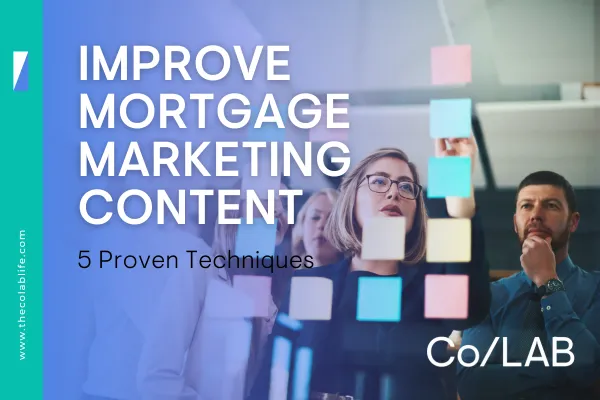BLOG
Mortgage, Real Estate, and Entrepreneurship


Improve Your Mortgage Marketing Content in 5 Steps
Improve Your Mortgage Marketing Content in 5 Steps
If there was one thing I did correctly when I started my first mortgage company, it was to invest in marketing and learning how to generate leads. I had absolutely no clue how I was going to do it, or what I needed to do, but I went on a journey that has led me down a path of figuring it out. At the core of everything I have figured out over the years is that “content” is at the heart of everything you do in marketing, in any business, not just a mortgage business.
Content creation is the foundation of effective marketing for any mortgage brokerage. Whether you aim to generate leads through organic means or paid campaigns, everything begins with compelling and valuable content. Here’s a step-by-step guide to improve your mortgage marketing content, helping you build a strong foundation, plan strategically, and maximize your reach.
Step1:
Build a Strong Content Foundation for Your Mortgage Business
To create an impactful content strategy, it's essential to start with a solid foundation where all your content will live. This means selecting the right platforms that align with your target audience's preferences and behaviors. Your content hub could be a well-optimized blog on your website, a YouTube channel for educational videos, or even a podcast series. It’s important to focus on platforms that you can consistently maintain, as a sporadic presence can harm your credibility.
Pro Tip: No matter which of the above you choose, having a website platform as your home base is a smart decision.
Additionally, setting up a content calendar is crucial to ensure consistency and to keep your audience engaged. A content calendar helps in planning, tracking, and scheduling posts, making it easier to coordinate various types of content and stay ahead of your marketing goals. It allows you to ensure a steady stream of valuable information that caters to the needs of prospective clients, whether they are first-time homebuyers, investors, or real estate agents looking to collaborate.
Choosing the Right Platforms for Your Content
When deciding where to post your content, consider your audience's behavior. Are they active on social media? Do they prefer watching videos or reading blogs? Mortgage brokers often find success with educational content on YouTube, blogs for SEO, and LinkedIn for professional networking. Go and check out the educational videos that I have on our YouTube channel, which has been one of our best organic content community builders:

Creating a Content Calendar to Stay Consistent
A content calendar helps you organize topics, assign deadlines, and plan ahead. This ensures that you are never scrambling for ideas and can maintain a consistent publishing schedule, crucial for building trust with your audience.
Optimizing Your Content Repository for SEO
Building a content repository is more than just creating posts; it’s about organizing them effectively and optimizing each piece for search engines. This ensures that your content reaches the right people when they need it most.
Pro Tip- In order to optimize and pick the right content, I suggest using a paid tool that helps you see what your clients are searching for. Here are a few I have used and still use to create our content:
VidIQ
Also Asked
Step 2:
Plan and Outline Content Types for Maximum Engagement
A successful content strategy involves planning and outlining the types of content that resonate with your target audience. For mortgage brokers, this means addressing the various stages of a client’s journey, from researching loan options to navigating the home buying process. Start by identifying 5 core content pillars that align with your business goals. Common examples include loan types, content tailored for first-time buyers, investor-specific advice, market trends, and FAQs about the mortgage process.
Each pillar should serve as a category under which you can create multiple content pieces. This makes your strategy organized and ensures that you’re covering a broad range of topics that are relevant to your audience. Planning content in this way not only helps you stay focused but also ensures that you address the pain points of different segments of your audience, making your marketing efforts more effective.
Identifying Your Audience and Their Needs
Understanding your audience’s needs is the first step in creating relevant content. For instance, first-time homebuyers often seek basic information on loan eligibility, while investors may look for insights on property financing options.
Exploring Different Content Formats Like Blogs, Videos, and Podcasts
Different people consume content in different ways. By diversifying your content types, such as creating video walkthroughs, blog posts, and podcasts, you can meet your audience wherever they are most comfortable.
Selecting 5 Core Content Pillars for Mortgage Marketing
Focus on creating content around key pillars like "Home Loan Options," "First-Time Buyer Tips," "Real Estate Investing," "Market Updates," and "Mortgage Myths Debunked" to cover a wide array of client interests.
Step 3:
Brainstorm, Research, and Expand Content Ideas
After setting your pillars, the next step is to brainstorm and research content ideas that fit under each category. This process involves analyzing what your competitors are doing, identifying trending topics through keyword research tools, and listening to the questions your audience frequently asks. Tools like Google Trends, Answer the Public, and SEMrush can help you find high-value topics that attract traffic.
Building a comprehensive list of ideas ensures that you always have a repository of content topics to choose from. This step allows you to plan your content calendar in advance and reduces the last-minute rush to create content. Aim to create a mix of evergreen content—articles that remain relevant over time—and timely content that addresses current market conditions.
Using Competitor Analysis for Content Inspiration
Competitor analysis can reveal gaps in the content available in your niche. Look at what topics competitors are covering and find ways to offer more value or a fresh perspective.
Utilizing Keyword Research Tools to Find Trending Topics
Use tools like Google Keyword Planner or SEMrush to discover what your target audience is searching for. Keywords like “best mortgage rates,” “refinancing options,” or “homebuyer tips” can serve as great starting points.
Building a Comprehensive List of Content Ideas for Each Pillar
Once you have your pillars, brainstorm ideas under each one. For example, under "Real Estate Investing," you could create content on “Top Financing Options for Investment Properties” or “How to Refinance a Rental Property.”
Step 4:
Create Core Content Pieces for Each Pillar
With your content ideas in place, it’s time to start building core content pieces for each pillar. Core content acts as a deep-dive into a subject and serves as a valuable resource for your audience. For example, a detailed guide on "Different Types of Home Loans" can serve as a reference point for clients at the beginning of their home buying journey. These pieces establish your authority in the industry and act as cornerstone content that can be repurposed into smaller, bite-sized formats.
Creating high-quality core content requires thorough research and attention to detail. Whether it’s a blog post, video series, or podcast episode, ensure that each piece answers key questions your audience may have. High-value content can help improve your website’s SEO, driving more organic traffic over time and establishing your mortgage business as a trusted resource.
Writing In-Depth Guides on Mortgage Loan Types
Guides like “Everything You Need to Know About FHA Loans” or “A Complete Guide to VA Loans” can attract clients looking for specific loan information and establish you as an expert.
Developing Video Tutorials for First-Time Homebuyers
Visual content is incredibly powerful. A video explaining “How to Get Pre-Approved for a Mortgage” can break down complex processes into manageable steps, attracting clients who prefer visual learning.
Crafting Infographics for Complex Mortgage Concepts
Infographics are perfect for explaining detailed mortgage concepts, like “The Mortgage Application Process” or “Steps to Closing on a Home Loan,” in a visually engaging way.
Step 5
Repurpose and Expand Core Content into Multiple Formats
One of the most efficient ways to maximize your content’s reach is through repurposing. This involves taking a piece of core content and adapting it into different formats for various platforms. For instance, a comprehensive blog post on “Investment Property Financing” can be broken down into a YouTube Video, social media posts, turned into an infographic, or adapted into a podcast episode. This way, you can reach different segments of your audience without creating new content from scratch.
Expanding core content into multiple formats ensures that your content works harder for you, reaching audiences who may prefer different ways of consuming information. Repurposing also allows you to maintain a consistent presence across platforms, making sure that your audience frequently encounters your brand and sees you as a go-to expert in mortgage advice.
Transforming Blog Posts into Social Media Snippets
Take key takeaways from your blog posts and turn them into quick tips or infographics for Instagram or LinkedIn. This keeps your social media pages active without needing new content every time.
Creating Podcasts from Webinars and Interviews
If you host webinars or interviews, repurpose those sessions into podcasts. This gives your audience the flexibility to consume content on-the-go, especially those who prefer audio content.
Using Infographics to Drive Engagement on Visual Platforms
Platforms like Pinterest and Instagram thrive on visual content. Use infographics from your guides to attract a visually-driven audience, providing valuable insights in a shareable format.
It will take you some time to work through the five steps, even the better part of a year. Once you get into a flow and you are consistently researching, creating and posting content, you are ready to start learning how to generate leads. Begin your journey, check out what others are doing on theirs and dive in!
Frequently Asked Questions:
Q: What types of content are most effective for mortgage marketing?
A: Educational content like guides, videos, and infographics that address common questions or concerns of homebuyers and investors tend to perform best.
Q: How can I improve SEO for my mortgage website?
A: Focus on keyword research, create high-quality content, optimize meta tags, and include backlinks to authoritative sources.
Q: What platforms are best for mortgage content marketing?
A: YouTube for video content, LinkedIn for professional engagement, and a blog on your website for SEO-optimized articles are excellent starting points.
Q: How do I create a content calendar for my mortgage business?
A: Use tools like Google Calendar, Trello, or Airtable to organize content topics by dates. Plan posts ahead of time to ensure a consistent presence.
Q: What are the top content ideas for mortgage brokers?
A: Topics like “How to Choose the Right Mortgage,” “Benefits of Refinancing,” and “Tips for First-Time Homebuyers” resonate well with potential clients.
Schedule A Call with Co/LAB by clicking the link below:


Improve Your Mortgage Marketing Content in 5 Steps
Improve Your Mortgage Marketing Content in 5 Steps
If there was one thing I did correctly when I started my first mortgage company, it was to invest in marketing and learning how to generate leads. I had absolutely no clue how I was going to do it, or what I needed to do, but I went on a journey that has led me down a path of figuring it out. At the core of everything I have figured out over the years is that “content” is at the heart of everything you do in marketing, in any business, not just a mortgage business.
Content creation is the foundation of effective marketing for any mortgage brokerage. Whether you aim to generate leads through organic means or paid campaigns, everything begins with compelling and valuable content. Here’s a step-by-step guide to improve your mortgage marketing content, helping you build a strong foundation, plan strategically, and maximize your reach.
Step1:
Build a Strong Content Foundation for Your Mortgage Business
To create an impactful content strategy, it's essential to start with a solid foundation where all your content will live. This means selecting the right platforms that align with your target audience's preferences and behaviors. Your content hub could be a well-optimized blog on your website, a YouTube channel for educational videos, or even a podcast series. It’s important to focus on platforms that you can consistently maintain, as a sporadic presence can harm your credibility.
Pro Tip: No matter which of the above you choose, having a website platform as your home base is a smart decision.
Additionally, setting up a content calendar is crucial to ensure consistency and to keep your audience engaged. A content calendar helps in planning, tracking, and scheduling posts, making it easier to coordinate various types of content and stay ahead of your marketing goals. It allows you to ensure a steady stream of valuable information that caters to the needs of prospective clients, whether they are first-time homebuyers, investors, or real estate agents looking to collaborate.
Choosing the Right Platforms for Your Content
When deciding where to post your content, consider your audience's behavior. Are they active on social media? Do they prefer watching videos or reading blogs? Mortgage brokers often find success with educational content on YouTube, blogs for SEO, and LinkedIn for professional networking. Go and check out the educational videos that I have on our YouTube channel, which has been one of our best organic content community builders:

Creating a Content Calendar to Stay Consistent
A content calendar helps you organize topics, assign deadlines, and plan ahead. This ensures that you are never scrambling for ideas and can maintain a consistent publishing schedule, crucial for building trust with your audience.
Optimizing Your Content Repository for SEO
Building a content repository is more than just creating posts; it’s about organizing them effectively and optimizing each piece for search engines. This ensures that your content reaches the right people when they need it most.
Pro Tip- In order to optimize and pick the right content, I suggest using a paid tool that helps you see what your clients are searching for. Here are a few I have used and still use to create our content:
VidIQ
Also Asked
Step 2:
Plan and Outline Content Types for Maximum Engagement
A successful content strategy involves planning and outlining the types of content that resonate with your target audience. For mortgage brokers, this means addressing the various stages of a client’s journey, from researching loan options to navigating the home buying process. Start by identifying 5 core content pillars that align with your business goals. Common examples include loan types, content tailored for first-time buyers, investor-specific advice, market trends, and FAQs about the mortgage process.
Each pillar should serve as a category under which you can create multiple content pieces. This makes your strategy organized and ensures that you’re covering a broad range of topics that are relevant to your audience. Planning content in this way not only helps you stay focused but also ensures that you address the pain points of different segments of your audience, making your marketing efforts more effective.
Identifying Your Audience and Their Needs
Understanding your audience’s needs is the first step in creating relevant content. For instance, first-time homebuyers often seek basic information on loan eligibility, while investors may look for insights on property financing options.
Exploring Different Content Formats Like Blogs, Videos, and Podcasts
Different people consume content in different ways. By diversifying your content types, such as creating video walkthroughs, blog posts, and podcasts, you can meet your audience wherever they are most comfortable.
Selecting 5 Core Content Pillars for Mortgage Marketing
Focus on creating content around key pillars like "Home Loan Options," "First-Time Buyer Tips," "Real Estate Investing," "Market Updates," and "Mortgage Myths Debunked" to cover a wide array of client interests.
Step 3:
Brainstorm, Research, and Expand Content Ideas
After setting your pillars, the next step is to brainstorm and research content ideas that fit under each category. This process involves analyzing what your competitors are doing, identifying trending topics through keyword research tools, and listening to the questions your audience frequently asks. Tools like Google Trends, Answer the Public, and SEMrush can help you find high-value topics that attract traffic.
Building a comprehensive list of ideas ensures that you always have a repository of content topics to choose from. This step allows you to plan your content calendar in advance and reduces the last-minute rush to create content. Aim to create a mix of evergreen content—articles that remain relevant over time—and timely content that addresses current market conditions.
Using Competitor Analysis for Content Inspiration
Competitor analysis can reveal gaps in the content available in your niche. Look at what topics competitors are covering and find ways to offer more value or a fresh perspective.
Utilizing Keyword Research Tools to Find Trending Topics
Use tools like Google Keyword Planner or SEMrush to discover what your target audience is searching for. Keywords like “best mortgage rates,” “refinancing options,” or “homebuyer tips” can serve as great starting points.
Building a Comprehensive List of Content Ideas for Each Pillar
Once you have your pillars, brainstorm ideas under each one. For example, under "Real Estate Investing," you could create content on “Top Financing Options for Investment Properties” or “How to Refinance a Rental Property.”
Step 4:
Create Core Content Pieces for Each Pillar
With your content ideas in place, it’s time to start building core content pieces for each pillar. Core content acts as a deep-dive into a subject and serves as a valuable resource for your audience. For example, a detailed guide on "Different Types of Home Loans" can serve as a reference point for clients at the beginning of their home buying journey. These pieces establish your authority in the industry and act as cornerstone content that can be repurposed into smaller, bite-sized formats.
Creating high-quality core content requires thorough research and attention to detail. Whether it’s a blog post, video series, or podcast episode, ensure that each piece answers key questions your audience may have. High-value content can help improve your website’s SEO, driving more organic traffic over time and establishing your mortgage business as a trusted resource.
Writing In-Depth Guides on Mortgage Loan Types
Guides like “Everything You Need to Know About FHA Loans” or “A Complete Guide to VA Loans” can attract clients looking for specific loan information and establish you as an expert.
Developing Video Tutorials for First-Time Homebuyers
Visual content is incredibly powerful. A video explaining “How to Get Pre-Approved for a Mortgage” can break down complex processes into manageable steps, attracting clients who prefer visual learning.
Crafting Infographics for Complex Mortgage Concepts
Infographics are perfect for explaining detailed mortgage concepts, like “The Mortgage Application Process” or “Steps to Closing on a Home Loan,” in a visually engaging way.
Step 5
Repurpose and Expand Core Content into Multiple Formats
One of the most efficient ways to maximize your content’s reach is through repurposing. This involves taking a piece of core content and adapting it into different formats for various platforms. For instance, a comprehensive blog post on “Investment Property Financing” can be broken down into a YouTube Video, social media posts, turned into an infographic, or adapted into a podcast episode. This way, you can reach different segments of your audience without creating new content from scratch.
Expanding core content into multiple formats ensures that your content works harder for you, reaching audiences who may prefer different ways of consuming information. Repurposing also allows you to maintain a consistent presence across platforms, making sure that your audience frequently encounters your brand and sees you as a go-to expert in mortgage advice.
Transforming Blog Posts into Social Media Snippets
Take key takeaways from your blog posts and turn them into quick tips or infographics for Instagram or LinkedIn. This keeps your social media pages active without needing new content every time.
Creating Podcasts from Webinars and Interviews
If you host webinars or interviews, repurpose those sessions into podcasts. This gives your audience the flexibility to consume content on-the-go, especially those who prefer audio content.
Using Infographics to Drive Engagement on Visual Platforms
Platforms like Pinterest and Instagram thrive on visual content. Use infographics from your guides to attract a visually-driven audience, providing valuable insights in a shareable format.
It will take you some time to work through the five steps, even the better part of a year. Once you get into a flow and you are consistently researching, creating and posting content, you are ready to start learning how to generate leads. Begin your journey, check out what others are doing on theirs and dive in!
Frequently Asked Questions:
Q: What types of content are most effective for mortgage marketing?
A: Educational content like guides, videos, and infographics that address common questions or concerns of homebuyers and investors tend to perform best.
Q: How can I improve SEO for my mortgage website?
A: Focus on keyword research, create high-quality content, optimize meta tags, and include backlinks to authoritative sources.
Q: What platforms are best for mortgage content marketing?
A: YouTube for video content, LinkedIn for professional engagement, and a blog on your website for SEO-optimized articles are excellent starting points.
Q: How do I create a content calendar for my mortgage business?
A: Use tools like Google Calendar, Trello, or Airtable to organize content topics by dates. Plan posts ahead of time to ensure a consistent presence.
Q: What are the top content ideas for mortgage brokers?
A: Topics like “How to Choose the Right Mortgage,” “Benefits of Refinancing,” and “Tips for First-Time Homebuyers” resonate well with potential clients.
Schedule A Call with Co/LAB by clicking the link below:

Are You Ready...
to Start Building a Legacy and Not Just a Business?
AS FEATURED IN:







Co/LAB Corporate
8795 Peach Street,
Erie, PA 16509
Company
Resources
Learn more about who we are, what we do, and how we can help you by visiting our other company websites.
www.becomeamortgagebroker.info





